- 02 Sep, 2024
When flying to your destination with any airline, you always wish to make your flight journey crucial and safely reach your destination on time. However, many airlines sometimes have to confront turbulence, an aircraft's unpredictable and often harsh movement caused by irregular airflow. It is a common occurrence in air travel, and it is caused by friction between the air and the ground, wildly irregular terrain, and artificial obstacles. You can figure out the intensity of this eddy motion, which depends on the surface wind's strength, the surface's nature, and the air's strength. It can be a havoc incident in which a passenger suffers a turbulence-related injury due to careless conduct by an airline employee or any oversight action. Still, the airline is liable of the airline for any resulting injuries. To be aware of such circumstances, you need to gather more details regarding turbulence injuries provided by the experts.
Are airlines liable for turbulence injuries?
Yes, airlines are liable for turbulence injuries, and if you are traveling with an international agreement, the Montreat Convent can make airlines liable for physical injuries from accidents on International flights. If you have selected the domestic airlines, it typically comes with minor discomfort and inconvenience, which you can sometimes face, leading to injuries. So, if you understand whether airines are liable for such injuries, it requires examining legal responsibilities and how they can harm yo by getting suitable information below.
-
Liability for Turbulence Injuries:
When you need to observe the airline's liability for turbulence injuries, it can be a complicated issue influenced by various factors, including the nature of the turbulence, the actions of the airline, and legal precedents. So, generally speaking, airlines are not directly liable for every injury caused by turbulence.
-
Unpredictable situations,
You might face unpredictable situations, and many factors, including weather conditions, jet streams, and atmospheric pressure changes, cause it. Hence, in these conditions, pilots and airlines cannot always foresee or avoid turbulence; they might not be held liable if an injury occurs during such an event.
-
Be wise with Duty of Care:
Many Airlines have a duty to ensure the safety of the passengers, which includes providing proper instructions, securing the cabin, and ensuring safety measures are in place. The airline could be liable if turbulence results in injuries due to neglect in fulfilling these duties, including failing to instruct passengers to fasten their seat belts or improperly securing loose items.
-
Legal Precedents:
It is essential to check out the previous legal cases, as courts often consider the specifics of each situation. If turbulence was mainly severe and unforeseeable, and the airline had adhered to all safety protocols, liability might not be assigned.
-
Regulations and standards:
Various national and international carriers regulate the aviation industry and set safety procedure standards. Presently, many airlines need to follow these regulations for significant results, including measures for dealing with turbulence and avoiding responsibility for injuries from turbulence.
How often are people injured by turbulence?
According to the Federal Aviation Administration (FAA), turbulence is one of the leading causes of non-fatal accidents in commercial aviation. Hence, Injuries from turbulence are relatively rare but occur in some unforeseen circumstances. If you check out the statistics between 2009 and 2018, turbulence caused around 20 to 30 serious injuries per year in the United States alone. Researchers from the Univerity of the USA have said that turbulence has increased in intensity, frequency, and duration in various regions worldwide. Thus, turbulence can lead to injuries, and the airlines are not directly and automatically liable for every incident. It is said that liability often depends on whether the airline followed appropriate safety protocols and the foreseeability of the turbulence. But adhering to the safety instructions and maintenance can help mitigate the risk of injuries from trubulence.










